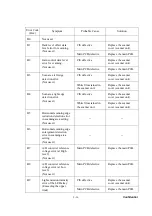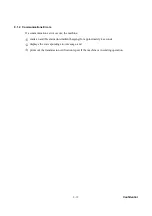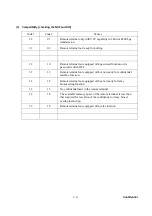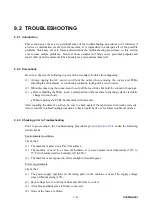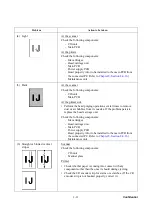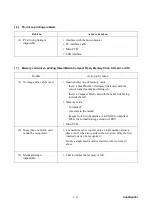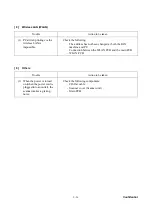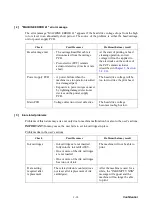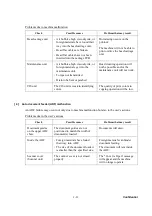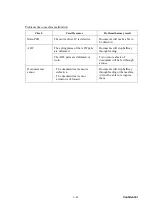
9 - 2 6
Confidential
9.2 TROUBLESHOOTING
9.2.1 Introduction
This section gives the service personnel some of the troubleshooting procedures to be followed if
an error or malfunction occurs with the machine. It is impossible to anticipate all of the possible
problems which may occur in future and determine the troubleshooting procedures, so this section
covers some sample problems. However, those samples will help service personnel pinpoint and
repair other defective elements if he/she analyzes and examines them well.
9.2.2 Precautions
Be sure to observe the following to prevent the secondary troubles from happening:
(1) Always unplug the AC power cord from the outlet when removing the covers and PCBs,
adjusting the mechanisms, or conducting continuity testing with a circuit tester.
(2) When disconnecting the connectors, do not pull the lead wires but hold the connector housings.
(3)
z
Before handling the PCBs, touch a metal portion of the machine to discharge static electricity
charged in your body.
z
When repairing the PCBs, handle them with extra care.
After repairing the defective section, be sure to check again if the repaired section works correctly.
Also record the troubleshooting procedure so that it would be of use for future trouble occurrence.
9.2.3 Checking prior to Troubleshooting
Prior to proceeding to the troubleshooting procedures given in
make the following
initial checks:
Environmental conditions
Check that:
(1) The machine is placed on a flat, firm surface.
(2) The machine is used in a clean environment at or near normal room temperature (10
°
C to
35
°
C) with normal relative humidity (20 to 80%).
(3) The machine is not exposed to direct sunlight or harmful gases.
Power requirements
Check that:
(1) The power supply specified on the rating plate on the machine is used. The supply voltage
stays within the rating ±10%.
(2) Each voltage level on AC input lines and DC lines is correct.
(3) All cables and harnesses are firmly connected.
(4) None of the fuses are blown.
Summary of Contents for DCP-340CW
Page 1: ...Confidential FACSIMILE EQUIPMENT SERVICE MANUAL MODELS MFC820CW MFC640CW DCP340CW ...
Page 9: ...Confidential CHAPTER 1 PARTS NAMES FUNCTIONS ...
Page 20: ...Confidential CHAPTER 2 SPECIFICATIONS ...
Page 37: ...Confidential CHAPTER 3 THEORY OF OPERATION ...
Page 80: ...Confidential CHAPTER 4 TRANSFER OF DATA LEFT IN THE MACHINE TO BE SENT FOR REPAIR ...
Page 85: ...Confidential CHAPTER 5 DISASSEMBLY REASSEMBLY AND LUBRICATION ...
Page 163: ...Confidential CHAPTER 6 ADJUSTMENTS AND UPDATING OF SETTINGS REQUIRED AFTER PARTS REPLACEMENT ...
Page 181: ...6 16 Confidential Vertical Alignment Check Patterns ...
Page 184: ...6 19 Confidential Margin Check Pattern ...
Page 193: ...Confidential CHAPTER 7 CLEANING ...
Page 196: ...Confidential CHAPTER 8 MAINTENANCE MODE ...
Page 205: ...8 7 Confidential Scanning Compensation Data List a b c d e f i ...
Page 207: ...8 9 Confidential Test Pattern ...
Page 212: ...8 14 Confidential Configuration List ...
Page 216: ...8 18 Confidential DCP340CW 1 2 3 4 6 5 7 11 12 13 8 14 15 9 10 Key Entry Order 2 ...
Page 232: ...8 34 Confidential 1st sheet 2nd sheet Vertical Alignment Check Patterns ...
Page 235: ...8 37 Confidential Margin Check Pattern ...
Page 249: ...Confidential CHAPTER 9 ERROR INDICATION AND TROUBLESHOOTING ...
Page 376: ...B Power Supply PCB U S A and Canadian models Confidential ...
Page 377: ...B Power Supply PCB European Asian and Oceanian models Confidential ...
Page 406: ...Confidential August 05 SM FAX046 8CA817 Printed in Japan ...





